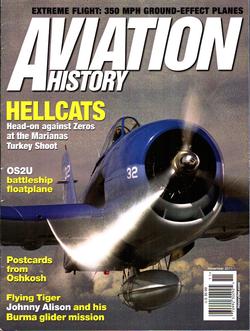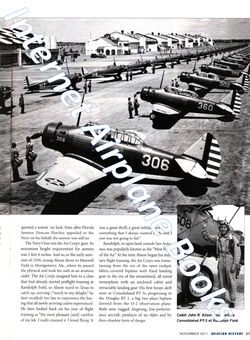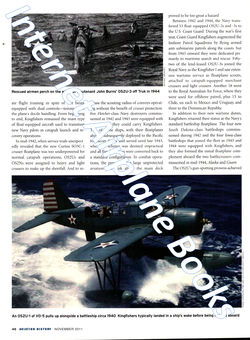AVIATION HISTORY NOV 11 F6F_FAIRCHILD_OS2U_AVG
ALISON_EKRANOPLAN_BAYLIES
WW2 GRUMMAN F6F
HELLCAT USN VF USMC VMF – FIRST BATTLE OF THE PHILIPPINE SEA
VISIONARY
AIRCRAFT DESIGNER SHERMAN FAIRCHILD
VOUGHT OS2U
KINGFISHER BATTLESHIP SPOTTER FLOATPLANE
POSTCARDS FROM
OSHKOSH EAA
AVG FLYING
TIGER JOHNNY ALISON AND HIS BURMA GLIDER MISSION
SOVIET EKRANOPLAN
350-MPH GROUND EFFECT
TEST PILOT
CORKY MEYER BROUGHT A DERELICT TBM AVENGER BACK TO LIFE
AMERICAN FRANK
BAYLIES BECAME A FRENCH SQUADRON’S TOP GUN OF 1918
US AIRWAYS
FLIGHT 1549 AIRBUS A320 “MIRACLE ON THE HUDSON”
COLORFUL
CHARACTERS IN THE COCKPIT
------------------------------------------------------------------------------------------
Additional Information from
Internet Encyclopedia
The Vought OS2U Kingfisher
is an American catapult-launched observation floatplane. It was a compact
mid-wing monoplane, with a large central float and small stabilizing floats.
Performance was modest because of its light engine. The OS2U could also operate
on fixed, wheeled, taildragger landing gear.
The OS2U was the main
shipboard observation aircraft used by the United States Navy during World War
II, and 1,519 of the aircraft were built. It served on battleships and cruisers
of the US Navy, with the United States Marine Corps in Marine Scouting Squadron
Three (VMS-3), with the United States Coast Guard at coastal air stations, at
sea with the Fleet Air Arm of the Royal Navy, and with the Soviet Navy. The
Royal Australian Air Force also operated a few Kingfishers from shore bases.
The Naval Aircraft Factory
OS2N was the designation of the OS2U-3 aircraft built by the Naval Aircraft
Factory in Philadelphia, Pennsylvania. The OS2U first flew on 1 March 1938.
In the late 1930s, Vought
engineer Rex B. Beisel was tasked with designing an observation monoplane
aircraft for the U.S. Navy suitable for a multitude of tasks including
directing battleship fire. In replacing the standard biplane observation
aircraft with a more modern monoplane design, Beisel incorporated innovations
making it the first production type to be assembled with spot welding, a
process Vought and the Naval Aircraft Factory jointly developed to create a
smooth fuselage that resisted buckling and generated less drag. Beisel also
introduced high-lift devices, spoilers and in a unique arrangement, deflector
plate flaps and drooping ailerons located on the trailing edge of the wing were
deployed to increase the camber of the wing and thus create additional lift.
For combat missions, the
pilot had a .30-caliber Browning M1919 machine gun, the receiver mounted low in
the right front cockpit, firing between the engine cylinder heads, while the
radio operator/gunner manned another .30-caliber machine gun (or a pair) on a
flexible Scarff ring mount. The aircraft could also carry two 100 lb bombs or
two 325 lb depth charges.[1] Additionally, the "Kingfisher", as it
was designated, served as a trainer in both its seaplane and landplane
configurations.
Beisel’s first prototype
flew in 1938, powered by an air-cooled, 450 hp Pratt & Whitney R-985-4 Wasp
Junior radial engine.
The first 54 Kingfishers
were delivered to the U.S. Navy beginning in August 1940 and six had been
assigned to the Pearl Harbor-based Battle Force before the end of the same
year. Many of the following 158 OS2U-2s were attached to flight training at
Naval Air Station Pensacola, Florida, but 53 were assigned to equip the newly
established Inshore Patrol Squadrons, based at NAS Jacksonville, Florida. In
1942, nine more Inshore Patrol Squadrons were established, all exclusively
equipped with OS2N-1s built by the Naval Aircraft Factory.
The Kingfisher was widely
used as a shipboard, catapult-launched scout plane on U.S. Navy battleships,
heavy cruisers and light cruisers during World War II, as well as playing a
major role in support of shore bombardments and air-sea rescue. Two examples
showing the plane's rescue capabilities include the recovery of World War I ace
Eddie Rickenbacker and his crew from the Pacific in November 1942[4] and
Lieutenant John A. Burns' unique use of the aircraft on 30 April 1944 to taxi
airmen rescued from Truk Lagoon to the submarine Tang, which was serving rescue
duty near the atoll on that date. In all, LT Burns rescued 10 survivors on two
trips and was awarded the Navy Cross for his efforts.
Australia received 18
Kingfishers from a batch of aircraft ordered by the Dutch East Indies that was
diverted to Australia in 1942. They were initially used as training aircraft
for pilots destined for flying boats, but in 1943, they were used to equip No.
107 Squadron RAAF, which carried out convoy escort duties until disbanded in
October 1945.[6] One Kingfisher was used in support of the Australian National
Antarctic Research Expedition in 1947–48.
Throughout its U.S. Navy
service, the OS2U and even its predecessor, the Curtiss SOC Seagull served much
longer than planned, as the planned successor, the Curtiss SO3C Seamew,
suffered from an insufficiently powerful engine which was a complete
failure.[8] The OS2U was only slowly replaced in the latter stages of World War
II with the introduction of the Curtiss SC Seahawk, the first examples reaching
the U.S. Navy in October 1944.
XOS2U-1 - Prototype Vought
Model VS.310 powered by a 450 hp (336 kW) Pratt & Whitney R-985-4 engine,
one built.
OS2U-1 - Initial production
variant as the prototype but powered by a 450 hp (336 kW) Pratt & Whitney
R-985-48, 54 built.
OS2U-2 - Production variant
with minor equipment changes and powered by a 450 hp (336 kW) Pratt &
Whitney R-985-50, 158 built.
OS2U-3 - Based on the
OS2U-2 with self-sealing fuel tanks, armour protection, two .30 cal (7.62 mm)
guns (dorsal and nose mounted), and able to carry 325 lb (147 kg) of depth
charges or 100 lb (45 kg) bombs, powered by a 450 hp (336 kW) Pratt &
Whitney R-985-AN2 engine, 1006 built.
OS2U-4 - Two aircraft
converted with narrow-chord and high-aspect ratio wings, also fitted with
full-span flaps. Not developed.
OS2N-1 - Naval Aircraft
Factory built OS2U-3 with a 450 hp (336 kW) Pratt & Whitney R-985-AN-2 or
-AN-8 engine, 300 built.
Kingfisher I - British
designation for the OS2U-3, 100 delivered to the Royal Navy.













